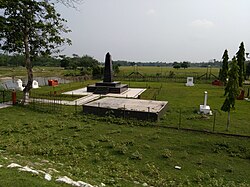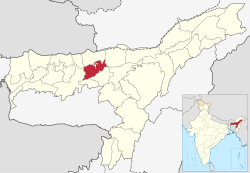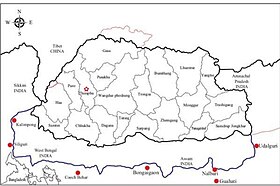District of Assam in India
| Darrang district | |
|---|---|
| District of Assam | |
 Swahid Stambha, Patharighat Swahid Stambha, Patharighat | |
 Location in Assam Location in Assam | |
| Darrang district | |
| Country | |
| State | Assam |
| Division | North Assam |
| Headquarters | Mangaldoi |
| Government | |
| • Lok Sabha constituencies | Mangaldoi |
| • Vidhan Sabha constituencies | Sipajhar, Mangaldoi, Dalgaon , Kalaigaon |
| Area | |
| • Total | 1,585 km (612 sq mi) |
| Population | |
| • Total | 928,500 |
| • Density | 590/km (1,500/sq mi) |
| Time zone | UTC+05:30 (IST) |
| ISO 3166 code | IN-AS |
| Website | https://darrang.gov.in/ |
Darrang (Assamese pronunciation: [dɔrɔŋ]) is an administrative district in the state of Assam in India. The district headquarters are located at Mangaldoi. The district occupies an area of 1585 km.
Etymology
The etymology of Darrang reflects its historical significance as a gateway. According to scholar Late Dineshwar Sarma, the name comes from the Assamese word "Doar," meaning "door," which refers to the alluvial floodplains in eastern and northeastern India that have long served as passageways for traders and travelers from the Himalaya and also as critical entry point for merchants from regions such as China, Tibet, Bhutan, and Central Asia.
History

No definitive records about Darrang are available for the pre-medieval period. According to Maheswar Neog, the Darrang became mentioned only after the uprising of the king Nara Narayan. Darrang at different times might have been under the rule of the Chutia Kingdom, Bodo people and Baro-Bhuyans.
During the reign of Dharmanarayan 3000 Chutia families were established in Darrang.
In the 16th century, Darrang was subject to the Kamata king Nara Narayan, and on the division of his dominion among his heirs, Darrang became a part of Koch Hajo. Early in the 17th century the Raja Bali Narayan invoked the aid of the Ahoms of Upper Assam against the Mughal invaders; after his defeat and death in 1637 the Ahoms dominated the whole district. About 1785 the Darrang rajas took advantage of the decline of the Ahom kingdom to try and re-establish their independence, but they were defeated by a British expedition in 1792, and in 1826 Darrang, with the rest of Assam, passed under British control.
By early 17th century, the Kingdom of Bhutan took control of the Darrang Duars as far as Gohain Kamal Ali road. The Bhutan control over these regions were through local authorities, who were appointed by Bhutanese provincial governors called Ponlops. By 1865, with the Duar Wars the British East India company took control of the Duars and removed Bhutanese influence from the area.
In 1785 it was Darrang was surveyed by one Ahom officer named Dhani Ram Gohain.
On 28 January 1894, there was a peasant's uprising against the increased land revenue by the British Raj in Patharighat, a village in Darrang district. In the British response that followed, 140 peasants belonging to both Hindu and Muslim communities died from bullet wounds and another 150 were injured.
In 1984 Sonitpur district was formed from part of Darrang. This was repeated on 14 June 2004 with the creation of Udalguri district.
Geography
Darrang district occupies an area of 1,585 square kilometres (612 sq mi).
National protected area
Darrang is home to Orang National Park, which it shares with Sonitpur district. Orang was established in 1999 and has an area of 79 km (30.5 sq mi).
Divisions
There are four Assam Legislative Assembly constituencies in this district: Kalaigaon, Sipajhar, Mangaldoi, and Dalgaon. Mangaldoi is designated for scheduled castes. All four are in the Mangaldoi Lok Sabha constituency.
Villages
Demographics
| Year | Pop. | ±% p.a. |
|---|---|---|
| 1901 | 99,002 | — |
| 1911 | 98,758 | −0.02% |
| 1921 | 110,391 | +1.12% |
| 1931 | 139,089 | +2.34% |
| 1941 | 188,189 | +3.07% |
| 1951 | 233,607 | +2.19% |
| 1961 | 310,321 | +2.88% |
| 1971 | 404,961 | +2.70% |
| 1991 | 618,653 | +2.14% |
| 2001 | 759,858 | +2.08% |
| 2011 | 928,500 | +2.02% |
| source: | ||
According to the 2011 census Darrang district has a population of 928,500, roughly equal to the nation of Fiji. This gives it a ranking of 463rd in India (out of a total of 640). The district has a population density of 586 inhabitants per square kilometre (1,520/sq mi). Its population growth rate over the decade 2001-2011 was 22.19%. Darrang has a sex ratio of 954 females for every 1000 males, and a literacy rate of 63.08%. 93.9% of the population live in rural areas while 6.1% live in urban areas. Poverty rate of the district stands at 45.5%. 5.98% of the population lives in urban areas. Scheduled Castes and Scheduled Tribes make up 4.34% and 0.91% of the population respectively.
Religions
| Religions in Darrang district (2011) | ||||
|---|---|---|---|---|
| Religion | Percent | |||
| Islam | 64.34% | |||
| Hinduism | 35.25% | |||
| Other or not stated | 0.41% | |||
| Circle | Muslims | Hindus | Others |
|---|---|---|---|
| Khoirabari (Pt) | 4.74% | 95.19% | 0.07% |
| Patharighat (Pt) | 35.18% | 64.69% | 0.13% |
| Sipajhar | 46.23% | 53.56% | 0.21% |
| Mangaldoi (Pt) | 42.36% | 57.22% | 0.42% |
| Kalaigaon (Pt) | 10.25% | 89.60% | 0.15% |
| Dalgaon (Pt) | 88.27% | 11.20% | 0.53% |
In Darrang district, as per the 2011 census record, Islam is the most followed religion with 597,392 adherents i.e. (64.34%), while Hinduism is followed by 327,322 i.e. 35.25% of the district population. Dalgaon in particular contained nearly half the population of the entire district. Way back in 1971, Hindus were slight majority in undivided Darrang district (which includes present Sonitpur and Udalguri districts) forming 70.3% of the population, while Muslims were 23.9% at that time.
Languages
Languages in Darrang district (2011)
Assamese (49.29%) Bengali (48.40%) Hindi (0.68%) Boro (0.45%) Bhojpuri (0.37%) Sadri (0.19%) Others (0.62%)At the time of the 2011 census, the Assamese-speaking population was 457,696 and the Bengali-speaking population was 449,205.
Notes
- "Darrang,Assam,India". darrang.nic.in. Retrieved 22 October 2020.
-
 One or more of the preceding sentences incorporates text from a publication now in the public domain: Chisholm, Hugh, ed. (1911). "Darrang". Encyclopædia Britannica. Vol. 7 (11th ed.). Cambridge University Press. p. 837.
One or more of the preceding sentences incorporates text from a publication now in the public domain: Chisholm, Hugh, ed. (1911). "Darrang". Encyclopædia Britannica. Vol. 7 (11th ed.). Cambridge University Press. p. 837.
- "Taking advantage of , the Bhutias pushed their southern boundary towards the plains and occupied the land upto the Gohain Kamal Ali." (Das 1998:13)
- "During the period of political uncertainty caused by the Ahom-Mughal conflict in the middle of seventeenth century, the Bhutias had taken possession of the whole of the fertile plain south of their hills as far as the Gohain Kamal Ali." (Das 1998:59)
- (Phuntsho 2013:394)
- "Patharughat martyrs yet to get recognition". The Assam Tribune Online. Retrieved 22 October 2020.
- Barua, Deepali (1994). Urban history of India : a case study (1st ed.). New Delhi, India: Mittal Publications. p. 149. ISBN 81-7099-538-8. OCLC 31711121.
- ^ Law, Gwillim (25 September 2011). "Districts of India". Statoids. Retrieved 11 October 2011.
- Srivastava, Dayawanti; et al., eds. (2010). "States and Union Territories: Assam: Government". India 2010: A Reference Annual (54th ed.). New Delhi, India: Additional Director General, Publications Division, Ministry of Information and Broadcasting (India), Government of India. p. 1116. ISBN 978-81-230-1617-7.
- Indian Ministry of Forests and Environment. "Protected areas: Assam". Archived from the original on 23 August 2011. Retrieved 25 September 2011.
- ^ "List of Assembly Constituencies showing their Revenue & Election District wise break – up" (PDF). Chief Electoral Officer, Assam website. Archived from the original (PDF) on 22 March 2012. Retrieved 26 September 2011.
- "List of Assembly Constituencies showing their Parliamentary Constituencies wise break – up" (PDF). Chief Electoral Officer, Assam website. Archived from the original (PDF) on 22 March 2012. Retrieved 26 September 2011.
- Decadal Variation In Population Since 1901
- ^ "District Census Handbook: Darrang" (PDF). censusindia.gov.in. Registrar General and Census Commissioner of India. 2011.
- US Directorate of Intelligence. "Country Comparison:Population". Archived from the original on 27 September 2011. Retrieved 1 October 2011.
Fiji 883,125 July 2011 est.
- "Darrang,Assam,India". darrang.nic.in. Retrieved 22 October 2020.
- "ASSAM HDR, 2014: POVERTY RATIO IS THE HIGHEST AMONG THE SCHEDULED TRIBES". nezine.com. Retrieved 22 October 2020.
- ^ "Table C-01 Population By Religion: Assam". census.gov.in. Registrar General and Census Commissioner of India. 2011.
- International Journal of Scientific and Research Publications https://www.ijsrp.org › ijsrp-...PDF The Change of Religion and Language Composition in the State of Assam ...
- ^ "Table C-16 Population By Mother Tongue: Assam". censusindia.gov.in. Registrar General and Census Commissioner of India. 2011.
References
- Das, Smriti (1998). Assam Bhutan relations with special reference to duars from 1681 to 1949 (PhD). Guwahati University. hdl:10603/67909. Archived from the original on 16 March 2023. Retrieved 17 March 2023.
- Phuntsho, Karma (2013). The History of Bhutan. Penguin Books. ISBN 9781908323583.
External links
| Places adjacent to Darrang district | ||||||||||||||||
|---|---|---|---|---|---|---|---|---|---|---|---|---|---|---|---|---|
| ||||||||||||||||
| Minority Concentrated Districts in India | |
|---|---|
| Andaman and Nicobar Islands | |
| Arunachal Pradesh | |
| Assam | |
| Bihar | |
| Delhi | |
| Haryana | |
| Ladakh | |
| Jharkhand | |
| Karnataka | |
| Kerala | |
| Madhya Pradesh | |
| Maharashtra | |
| Manipur | |
| Meghalaya | |
| Mizoram | |
| Odisha | |
| Sikkim | |
| Uttar Pradesh | |
| Uttarakhand | |
| West Bengal | |
| Source: "List of 90 Minority Concentration Districts" (PDF). www.minorityaffairs.gov.in. Retrieved 2 September 2020. | |
26°45′N 92°30′E / 26.750°N 92.500°E / 26.750; 92.500
Categories: